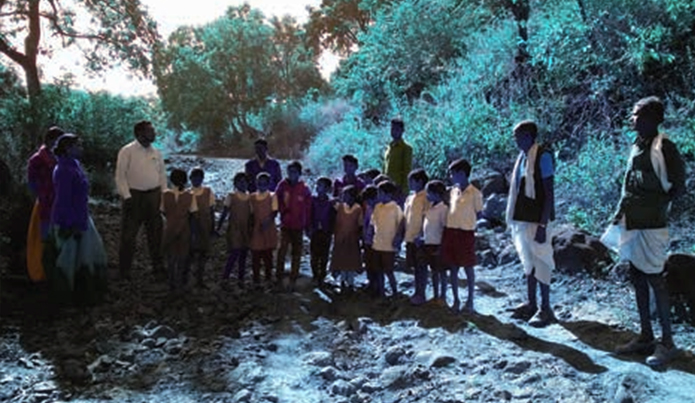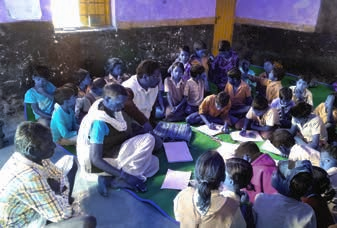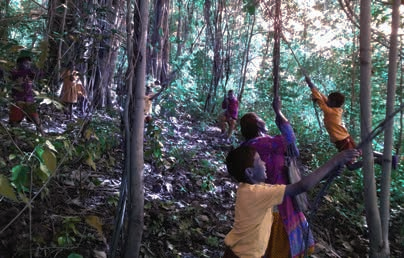Forest Defenders

Abstract
The small and marginal Indigenous community in the forest fringe areas had intergenerational knowledge of the surrounding ecosystem, which shaped their farming practices. This phenomenon has gradually changed over the past 30–40 years, when seed, fertiliser or pesticide companies started pushing for new technologies and products, assuring higher yield. The farmers began following the practices prescribed by the companies and gradually forgot the intricate knowledge and skills required for living in their ecosystem – a phenomenon called de-skilling. The Adaptive Skilling through Action Research (ASAR), initiated by an Indian non-profit organisation and an academic institution with Indigenous communities, is a quest to find out ways to change these trends. Increasing dependency on markets made the younger generation in the Ghughri village of Madhya Pradesh ignorant about the plants available in their village and the nearby forest. Whereas, according to the elderly people in the village, these plants were meeting most of their daily needs. Ignorance and lack of interest of the younger generation have resulted in useful trees being replaced for timber species by the forest department and illegal felling by neighbouring villagers. In ASAR, elderly people engaged with the younger generation and walked around their village and forest in order to understand floral diversity and its use. They made a biodiversity register with information about different species of plants. This article illustrates how this intergenerational knowledge transfer helped the younger generation take interest in the forest and turn all the villagers into forest defenders.
On 30 January 2019, on a sunny winter morning, 10-year-old Khilawan and a group of around 25 villagers, comprising of children, young adults and the elderly, were scouting the forest adjacent to Ghughri, their village, in the Dindori district of Madhya Pradesh, India.
Their faces beamed with excitement and interest as they were discovering the richness and diversity of the jungle. They walked almost seven kilometres across the forest to become familiar with the varieties of plants and animals, and understand their dependence on the forest products.
With the premise that villagers would protect forests if they acknowledged it as an inherent part of their life, elders of Ghughri helped the younger generation discover the rich biodiversity of their forest. While the villagers turn into forest defenders, the children embrace conservation by documenting the species in a biodiversity register.
New learning
During the walk, the group collected leaves, bark and flowers, and understood how the parts of different plants are used by the villagers for different purposes. They also developed understanding about the occurrence of certain plants in particular parts of the jungle. They came to know about many trees and plants that were an integral part of their lives, but were disappearing fast from their jungle. For example,tinsa (Ougeinia dalbergioides) was used for making plough; plants such as ,bel (Aegle marmelos), harra (Terminalia chebula), bahera (Terminalia belerica), amla (Phyllanthus emblica), kumbhi (Careya arborea), jamrashi (Elaeodendron glaucum), banda (Loranthus longiflorus), satavar, batua, and surteli,14which have medicinal use and can cure illnesses like abdominal pain, snake bites, rabies and indigestion, besides respiratory and heart diseases.
They came to know about trees, whose leaves and bark were used to catch fish, and trees whose leaves were consumed as food, which are now found in smaller numbers in the forest. They also were introduced to trees such as tendu (Diospyros melanoxylon), chaar and kusum (Schleichera oleosa) which are of economic importance. They additionally discovered the vast number of species that were still present in the village even after extensive deforestation; the group found many animals or their traces in the forest.
Documenting biodiversity
The children realised that various plants and animals were decreasing rapidly and that local knowledge about these species would be lost with the older generation. It was important to pass the elders’ wisdom to the younger generation and document it in an easily understandable manner.
Khilawan and his friends in the primary school made a biodiversity register with dried leaves, flowers and barks that they collected. They wrote the local names of the plants, their usage and occurrence in the register. The register would be kept in their school.

Children preparing biodiversity register with help from elders.
Hiralal, their teacher, assured them that he would help them update the register with details whenever they found a new species. The villagers now know that this register will help them find the species that are disappearing fast.
Dependence on forests
This work started with the Adaptive Skilling through Action Research (ASAR), a joint action research of Professional Assistance for Development Action (PRADAN15) and Azim Premji University (APU16). ASAR’s objective is to find ways to reverse deskilling through adaptive skilling.
Ghughri, a forest village about nine kilometres from Amarpur, the administrative block headquarters, is one of the three villages chosen for the action research. More than 84% of its population are Gond, an Adivasi (Indigenous group of people).
Forests, with their diversity of flora and fauna, have been an integral part of the lives and livelihoods of Adivasis in central Indian Plateau. Forests are their source of food, fodder, fuel, medicine and timber, as well as manure in the form of decomposed leaves and branches for the lands in the lower catchment.
Forest degeneration
After the forest department was established, the floral diversity started decreasing gradually, as they started planting/nurturing only timber species. At the same time, with the advent of modern agriculture, seeds of high yielding or hybrid varieties, along with chemical fertilisers and pesticides, gave the farmers an assurance of higher yield.
The farmers started practicing what the seed, fertiliser and pesticide companies prescribed. They gradually became dependent on the inputs supplied by these companies, and no longer needed the intricate knowledge about the forest-farm production system.
Gradually the farmers forgot their generations-old knowledge and skills – a phenomenon called de-skilling. They became passive observers to the decline of their forest.
In general, in the Adivasi villages that fringe the forests, the elderly people are still concerned about the decline whilst the younger generation have neither the knowledge about the plants in the forest nor are they bothered about their gradual destruction.
Forest defenders
Elderly people like Gangaram, who felt that the young generation’s lack of knowledge about their forest resulted in the lack of interest in protecting it, decided to educate them about the forest.
The idea that “forests could be protected if the youth knew about the different species and their uses”, was unique. The method that the elders adopted to transfer this knowledge to the younger generation, through a walk in the forest, was also unique. The walk also enabled the creation of a biodiversity register.
This awareness helped the villagers start guarding the forest. The villagers divided into groups and started guarding different parts of the forest to stop illegal felling, and confiscated the axes and wooden logs from outsiders coming to the forest to cut trees. Ramki Bai of Ghughri said that people from all the adjacent villages got the message that villagers of Ghughri were against illegal felling.
Villagers of Ghughri plan to take this initiative to nearby villages and involve schools, so that a movement can be created to pass on the knowledge through generations towards forest conservation. The forests will thus be rejuvenated and the people of Ghughri will reside in the village they dream of.

Children enjoying in the village.

